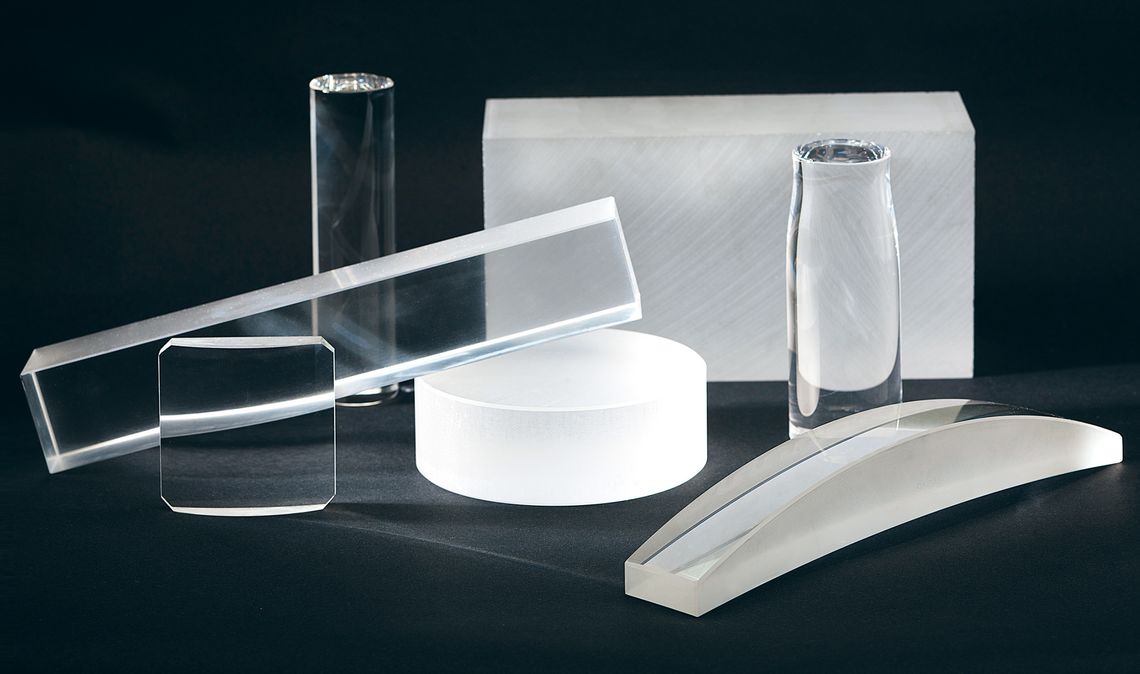SQ Fused Silica by weinert-industries
SQ Fused Silica

Ultrapure Synthetic Fused Silica
The SQ Fused Silica ingots, after undergoing a process of fusion, cooling, and polishing, are sorted into distinct quality categories based on established measurement and selection methods. These can be customized and supplied to meet the specific needs of individual customers. This adaptability allows for the use of Fused Silica in a wide range of optical applications, spanning from deep ultraviolet (DUV) to near-infrared (NIR).
- SQ Fused Silica provided in various forms such as polished ingots or semi-finished items (including discs, rods, plates, blocks, etc.), available in five grades based on uniformity, striae absence, and suitable wavelength ranges.
- Flexible product range due to advanced manufacturing techniques, encompassing rods, discs, plates, blocks, and prisms.
- Fused Silica characterized by its purity, free from bubbles and inclusions, ideal for laser and optical applications.
- Exceptionally low levels of fluorescence and superior laser durability, attributed to its high content of OH and H2.
- Offered with detailed optical characteristics documentation, featuring:
- Exceptional uniformity
- Minimal stress-induced birefringence
- High light transmission at 193 nm and 248 nm wavelengths
Range of products and services
Quality grades SQ Fused Silica
(as per customer-specific requirements)
- SQ0: A 3D material that is free of striae and striations in any functional direction. Recommended for optical elements utilizing multiple light directions, such as prisms or high-curvature lenses.
- SQ1: A 1D material with high homogeneity and free of striae and striations in the functional direction. Typical applications include optical elements such as lenses, discs, plates, wafers, and rods/fibers.
- SQT: Not specified in terms of homogeneity, striae, and striations. This quality grade is recommended for technical applications.
- Excimer-grade Fused Silica – available as SQ1 or SQ0: excellent transmission at 193 nm / 248 nm. Lowest level of laser-induced fluorescence (LIF)
- SQ0-E193/SQ1-E193 (ArF excimer-grade)
- SQ0-E248/SQ1-E248 (KrF excimer-grade)
- SQ0-E193/SQ1-E193 (ArF excimer-grade)
- SQ0-E248/SQ1-E248 (KrF excimer-grade)
Product properties SQ Fused Silica
The material, notable for being almost entirely devoid of inclusions and bubbles, boasts an impressive array of optical and physical characteristics:
- High resistance to laser damage
- Uniformity in refractive index
- Robust thermal stability and resistance to temperature fluctuations
- Minimal stress-induced birefringence
- Low coefficients of thermal expansion
Thanks to its significant OH and H2 content, our Fused Silica demonstrates extremely low levels of fluorescence and maintains excellent stability when exposed to high-energy UV light and laser radiation.
Ordering options SQ Fused Silica
- Various geometries
- 5 quality grades
- Surface quality/finishing
Fields of use
- Optics for excimer lasers and systems for beam guidance
- Components for deep ultraviolet (DUV) and ultraviolet (UV) optics
- Optical materials for line beam systems, utilized in the production of OLEDs
- UV rods, preforms, and optical fibers
- Applications in laser fusion technology
- Utilization of Fused Silica in the creation of vessels and windows for technical applications
- Use in lithography and microlithography, including stepper lenses, photomask blanks, wafers, and lithography optics
Applications
Other Products
Contact
Please contact us for further information. We look forward to your inquiry.
Europe, Africa, and Asia (excl. China)
Phone +49 36764-81-100
Email sales-europe@weinert-industries.com
China
Phone +86
519-8988-7783
Email sales-china@weinert-industries.com
North and South America
Phone +1
757-258-4805
Email sales-americas@weinert-industries.com
